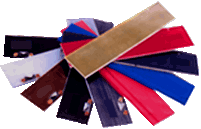|
Roll Hardness
Doctor blade material selection and Doctor Blade thickness are primarily determined by the roll material and roll hardness. Soft rolls (over 10-15P&J) generally use either 2.3mm thick synthetic or 4 mm thick polyethylene Doctor Blades. This reduces the risk of the Doctor Blade digging into the cover and causing damage. These are primarily applicable in the wire part and sometimes press part as deflectors.
A hard roll in the press, calendar or sometimes in the wire generally needs a thinner synthetic fiberglass Doctor Blade ranging from 1.5-1.9mm thick. Final thickness selection is determined by weighing several factors including holder design. While thinner Doctor Blades often clean the roll more efficiently due to higher shearing action, whereas higher thickness can often improve Doctor Blade life.
Bevel Angle
Experience has shown that the bevel angle must be as equal as possible to the working angle. The bevel angle however cannot be too acute so as
to ensure that during high linear load application the tip does not bend . At the same time the bevel angle cannot be too high so that that the doctored material are not easily removed . Keeping in view the aforesaid factors most doctor blades are supplied with a standard 30-degree bevel with a flat land area. Bevel angles are measured as indicated
in the sketch. Most of the doctors perform well with this standard bevel
a ngle. Soft rolls may require a higher bevel angle to reduce the risk of roll damage. Hard rolls allow for greater flexibility in selecting a lower bevel angle. Lower bevel angles may improve roll-cleaning efficiency, since this leads to reduction in surface area of the Doctor Blade tip, it may result in rapid initial Doctor Blade wear. ngle. Soft rolls may require a higher bevel angle to reduce the risk of roll damage. Hard rolls allow for greater flexibility in selecting a lower bevel angle. Lower bevel angles may improve roll-cleaning efficiency, since this leads to reduction in surface area of the Doctor Blade tip, it may result in rapid initial Doctor Blade wear.
We can manufacture tailor-made Doctor Blade bevel solutions that can enhance doctor efficiency. Specific angles can also be supplied to improve sheet shedding.
Fasteners
A Complete Range Of Doctor Blade Fasteners and rivets are imported from our Licensor Bonetti SpA,
 Italy to suit Any Doctor Blade Holder. Doctor blades are inserted and fixed in each type of holder by fasteners and rivets attached to the Doctor Blade. Every doctor blade is designed to fit in a specific type of Doctor Blade holder. Italy to suit Any Doctor Blade Holder. Doctor blades are inserted and fixed in each type of holder by fasteners and rivets attached to the Doctor Blade. Every doctor blade is designed to fit in a specific type of Doctor Blade holder.
Each holder type has its own specific fastener requirements. Fasteners must be correctly sized and installed to specific specifications. A Doctor Blade with incorrect dimensions of Fasteners and rivets , could fall out of holder during operation or unloaded condition , with significant risk of felt and machine damage. Pitch or
Spacing of fasteners also depends on whether a Doctor Blade can be inserted in the holder
from the machine side (END REMOVAL) or whether it must be inserted into the holder from the front (FRONT REMOVAL).
Doctor Blade holder type decide the thickness of the Doctor Blade that can be used.
Use of a 
thicker synthetic Doctor Blade to replace metallic Doctor Blades can be accomplished by
supplying a Doctor Blade with thickness reduction at the back surface or an attached backing blade. In some cases, it may be necessary to install a new pressure plate assembly.

[ Top
]
|